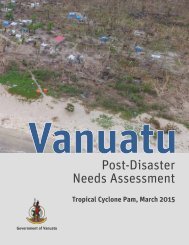Fiji
yqgk302EGjo
yqgk302EGjo
Create successful ePaper yourself
Turn your PDF publications into a flip-book with our unique Google optimized e-Paper software.
FIJI Post-Disaster Needs Assessment<br />
Table 68: Total Recovery and Reconstruction Needs for the Environment Sector (F$ million)<br />
Increase operational cost to farmers to manage invasive tree<br />
species<br />
Strengthen and enforce planning and environmental legislative<br />
and institutional frameworks<br />
Recovery Reconstruction Resilience Total<br />
10.1 10.1<br />
5.0 5.0<br />
Provide operational funds for FADs 0.9 0.9<br />
Increase operational costs for the management of protected<br />
coral reef, mangrove and native forest reserves/national parks<br />
Increased cost of ecological surveys, damage assessment,<br />
monitoring and recovery of ecosystem asset and establishing<br />
a centralised database<br />
Clearance of debris in cities and villages (housing, green<br />
waste, etc.) and clearance of agricultural land<br />
Special treatment for potentially recyclable/reusable material<br />
and hazardous waste<br />
3.0 3.0<br />
8.2 8.2<br />
28.1 28.1<br />
5.5 5.5<br />
Replanting of mangroves 1.8 1.8<br />
Assisting recovery of coral reefs through transplants and<br />
protection<br />
Waste processing equipment (cost of compactor and<br />
shredders)<br />
4.7 4.7<br />
6.6 6.6<br />
Total 60.8 13.1 73.9<br />
Source: Estimations by Assessment Team.<br />
Note: A detailed breakdown of recovery needs by sector is included in Annex 2.<br />
In economic terms, damage and losses to ecosystems are extensive in the provinces affected by TC Winston. The monetary<br />
values reflect the richness of <strong>Fiji</strong>’s ecosystems and their importance to its people, livelihoods and the economy. The<br />
proposed and costed activities are aimed at supporting recovery of these ecosystems and are relatively modest compared<br />
to estimated losses. However, for the people and their livelihoods, the time that the ecosystems will need to recover will<br />
also mean continued socioeconomic impacts. Thus, ensuring that people’s needs are met through other support (such as<br />
FADs) is critical for guaranteeing that ecosystems are not placed under additional pressure and have time to recover and<br />
help meet the people’s needs in the near future.<br />
3.4.2 Gender and Social Inclusion<br />
Summary<br />
The impact of TC Winston will be felt along the social lines and disparities that exist within <strong>Fiji</strong>an society. Gender inequality<br />
is one of the determinants that has shaped not just who has been adversely affected by the disaster, but also who has the<br />
capacity to recover from it. It will also determine men’s and women’s participation in and benefit from recovery interventions<br />
and their general resilience to future disasters. Women, who make up about 49 percent of the <strong>Fiji</strong>an population, are the<br />
largest disadvantaged population that has been negatively affected by TC Winston. While men are overrepresented in<br />
waged on- and off-farm employment, the high burden of reproductive work confines women to the poorly remunerated<br />
informal sector, particularly subsistence agriculture, which leaves them with no income security to respond to the disaster.<br />
Yet women’s subsistence activities and earnings contribute directly to nutritional security and household economic welfare<br />
and foster human welfare. The impact of the cyclone on women may, therefore, result in increasing dependency on<br />
subsistence economic activity, increasing time poverty, deepening their poverty and widening gender inequality. While<br />
women have been disproportionately impacted by the cyclone, simply viewing them as victims only exacerbates their<br />
vulnerability. Instead, recognizing that they have knowledge, social capital and skills critical for recovery is important.<br />
Recovery interventions in housing and productive sectors present an opportunity to start redressing some of the inequalities<br />
that put women in a disadvantageous position. The gender gap of 34.9 percent points in labour force participation rates<br />
suggests significant opportunity to engage more women in recovery and reconstruction to rebuild their livelihoods, increase<br />
their asset base and achieve long-term resilience. Ensuring that no discrimination exists based on sex, age, ethnicity,<br />
sexual orientation or disability at all stages of the recovery process is also crucial.<br />
Tropical Cyclone Winston, February 20, 2016<br />
99



